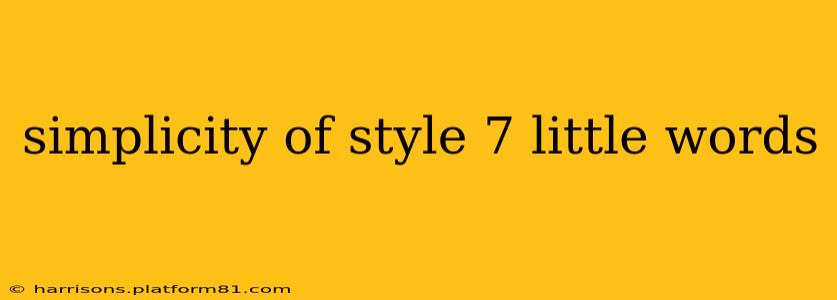Simplicity of Style: 7 Little Words That Pack a Punch
Simplicity in writing style isn't about dumbing things down; it's about clarity, precision, and impact. It's about conveying your message effectively with the fewest words possible, leaving a lasting impression. Achieving this seemingly simple goal requires careful consideration of several key elements. This post explores how to master a simple writing style, focusing on techniques to maximize impact and leave readers wanting more.
What Makes a Writing Style Simple?
Simplicity in writing is about clear communication. It's not about using a limited vocabulary or avoiding complex ideas, but about expressing those ideas with precision and efficiency. It's about choosing the right word at the right time, eliminating unnecessary jargon, and focusing on the core message. A simple writing style isn't simplistic; it's elegant in its efficiency.
What Are the Benefits of a Simple Writing Style?
A simple writing style offers numerous benefits:
- Increased Readability: Readers can easily understand your message without getting bogged down in complex sentence structures or overly verbose language.
- Enhanced Clarity: Your points are conveyed directly and unambiguously, reducing the potential for misinterpretation.
- Improved Engagement: Readers stay focused and interested because they aren't struggling to decipher your meaning.
- Stronger Impact: Concise, well-chosen words resonate more powerfully than rambling prose.
- Wider Audience Reach: Simplicity makes your writing accessible to a broader range of readers, regardless of their background or level of expertise.
How to Achieve Simplicity in Your Writing: Seven Key Strategies
Here are seven practical strategies to help you achieve simplicity in your writing style:
-
Use Short Sentences: Short sentences are easier to read and understand. Avoid long, rambling sentences that can confuse the reader.
-
Choose Strong Verbs: Active voice and strong verbs add power and directness to your writing. Instead of "The ball was thrown by John," write "John threw the ball."
-
Employ Precise Language: Select words that accurately convey your intended meaning. Avoid vague or ambiguous terms. For example, instead of "a lot of people," use a more precise term like "many," "several," or a specific number.
-
Eliminate Jargon and Clichés: Avoid technical terms or overly familiar phrases that might confuse or bore your readers. Strive for originality and authenticity.
-
Show, Don't Tell: Use descriptive language and vivid imagery to engage your readers' senses. Instead of saying "The room was messy," describe the scattered papers, overflowing trash can, and unmade bed.
-
Break Up Long Paragraphs: Long paragraphs can be daunting for readers. Break them up into shorter, more manageable chunks to improve readability.
-
Read Aloud: Reading your work aloud helps you identify awkward phrasing, long sentences, and areas where you can improve clarity.
What are some examples of simple writing styles?
Many prominent writers are known for their simple yet impactful styles. Ernest Hemingway's minimalist prose is a classic example, characterized by short sentences, direct language, and impactful imagery. Similarly, George Orwell's writing emphasizes clarity and precision, avoiding unnecessary complexity. Modern examples can be found in successful blog posts and online articles that prioritize reader engagement through clear and concise language. Analyzing these examples can help you develop your own simple and effective style.
How do I know if my writing style is too simple?
The goal is not to make your writing too simple, but to achieve a balance between clarity and sophistication. If your writing feels dull, lifeless, or lacks depth, you might need to add more complexity. However, if your writing is difficult to understand or overly verbose, then simplifying it will likely enhance its impact and readability. The key is finding the right balance, which comes with practice and careful self-editing.
By focusing on these seven strategies, you can significantly improve the simplicity and impact of your writing, ensuring your message resonates with readers and leaves a lasting impression. Remember, simple doesn't mean simplistic – it means powerful and effective.
